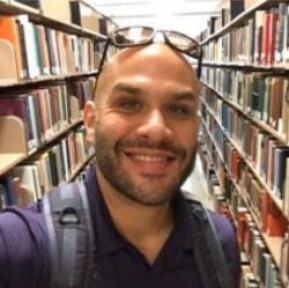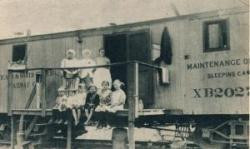David Colon's collections
Traqueros, part 1: The Mexican American Railroad Workers
<p><em>Traqueros</em> ('track workers') were Mexican and Mexican American laborers who were instrumental in the building and expansion of the railroad throughout the U.S., from the mid- to late-19th century until the early- to mid-20th century. </p>
<p>Following the implementation of the Chinese Exclusion Act (1882), Chinese immigrant labor - central to the construction of the transcontinental railroad (1869) - was extremely curtailed, and Mexican workers were relied upon to fill the labor void. By 1900, U.S. railroads employed over 1 million people, which increased to almost 1.8 million by 1925. According to the late historian Jeffrey Marcos Garcilazo, in his book <em>Traqueros: Mexican Railroad Workers In The United States, 1870-1930</em> (2012): "Between 1880 and 1930, Mexican track workers constituted almost two-thirds of the track labor forces in the Southwest, Central Plains, and Midwest" (p.34). </p>
<p>The U.S. federal government's Immigration Act (1917), while curtailing European immigration, exempted Mexican immigrants coming to work in the U.S. from its restrictions, largely because of the abundant reliance on Mexican labor in the railroad industry. By even the 1890s, the U.S. railroad labor force was so largely Mexican that the Southern Pacific Railroad adopted the practice of employing Mexican cooks in their workers' camps to satisfy the appetites of their immigrant laborers. <br /></p>
<p>The legacy of <em>traqueros</em> is largely forgotten in U.S. history books about labor and the building of our country, but recent and ongoing scholarship is revealing the vital role of <em>traqueros</em> in the strengthening of the U.S. economy, transportation system, and large-scale industry since the Civil War.</p>
<p>#EthnicStudies #MexicanAmericans #Traqueros #Railroads #Latinos #Chicanos</p>
<p><br /></p>
 David Colon
David Colon
3
Traqueros, part 3: The Art of Martín Ramírez (1895–1963)
<p>Martín Ramírez (1895–1963) was born in Jalisco, Mexico. He emigrated to the U.S. in 1925 to work in California as a miner and a <em>traquero</em>. Poverty and his need to seek steady work forced him to leave his wife Ana and their four children in Mexico. The Great Depression left him unemployed, and acute mental illness led him to be remanded to the DeWitt State Hospital in Auburn, California in 1948, where he lived until his death in 1963.</p>
<p>As told by the curators at the Smithsonian American Art Museum: "Around 1948, Ramírez began to draw on an eclectic array of paper surfaces—brown wrapping paper, laundry lists, paper cups, old letters—which were glued together to form a unified drawing area. He made use of a variety of tools and techniques, including crayons, colored pencils, watercolors, chalk, ink, and collage.</p>
<p>"Ramírez's motifs reflect his life in two distinct cultures. His highly patterned, intricate drawings present fantastic renditions of subjects such as Mexican soldiers, Madonnas, prairie dogs, cars, and trains. In terms of technique, what is most extraordinary in Ramírez's art is his use of line to create the many different kinds of space—niches, frames, stages—in which his protagonists are placed. Although flatness characterizes the overall effect of his technique, the numerous parallel lines in Ramírez's work bring about a sense of visual depth."</p>
<p>About 450 of Martin Ramirez's drawings and collages are known to exist. He is widely regarded as one of the 20th century's greatest autodidactic artists. His work has been presented in solo exhibitions at museums around the world, including the <em>Centro cultural/Arte contemporáneo </em>in Mexico City (1989), the American Folk Art Museum in New York City (2007, 2009), and the <em>Museo nacional centro de arte Reína Sofía</em> in Madrid (2010).</p>
<p>#EthnicStudies #MexicanAmericans #Traqueros #Railroads #SelfTaught #Latinos #Chicanos #Artists #MartinRamirez</p>
 David Colon
David Colon
5
Traqueros, part 2: Chain Migration and Boxcar Communities
<p>A profound result of the vast employment of <em>traqueros</em> in the transportation industry was the railroads' corporate strategy to establish means for "chain migration." Chain migration refers to the process of immigrants from a particular region or town following the path of prior immigrants (from their same region or town) to the same destination. </p>
<p>As the agricultural, petroleum, and cattle ranching industries of the Southwest expanded to a vast scale in the early 20th century, the demand for <em>traquero</em> labor grew as well. To meet this demand, companies like the Santa Fe Railroad incentivized <em>traqueros</em> to bring along their families, including wives and children, to live on sites by the rail yards rent-free. </p>
<p>A key tactic in this strategy was the practice of housing <em>traqueros</em> in converted boxcars. These converted boxcars would be grouped together into settlements, which tended to be of two types: one was a species of "mobile villages" that moved along the train tracks, whereas the other type was comprised by taking boxcar quarters off the rails and grouping them together on the outskirts of rail yards in areas usually saved for section gangs. Historian Al Camarillo, in his book <em>Chicanos in a Changing Society: From Mexican Pueblos to American Barrios in Santa Barbara and Southern California, 1848-1930</em> (1979) has termed the process of establishing boxcar settlements as "barrioization," because these family-centered communities demonstrated the sustainability of Mexican American communities, as well as familiarized Mexican immigrants with different parts of the U.S. that would become significant Mexican immigrant destinations.</p>
<p>Mexican boxcar communities existed all over the country and in major cities including Chicago, Pittsburgh, Los Angeles, and San Diego. </p>
<p>On April 18th, 2016, Dr. Antonio Delgado, a former Smithsonian Institution Visiting Scholar (1998), presented his research on Mexican boxcar communities in Chicago at the McHenry County Historical Society Museum. Illinois Humanities sponsored the event, publishing the <em>Daily Herald</em>'s notice of the program on the Illinois Humanities' <a href="https://www.ilhumanities.org/news/2016/04/explore-history-of-the-mexican-railroad-boxcar-communities-in-chicago/">news blog</a>. The online story includes a trailer for local station WTVP's documentary, <em>Boxcar People</em>, for which the now adult children of <em>traqueros</em> were interviewed. </p>
<p>#EthnicStudies #MexicanAmericans #Traqueros #Railroads #BoxcarCommunities #ChainMigration #Latinos #Chicanos</p>
 David Colon
David Colon
6


